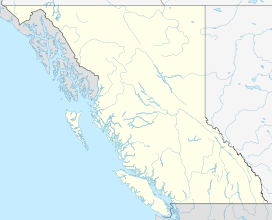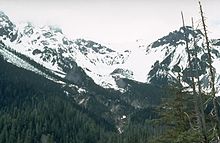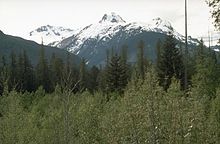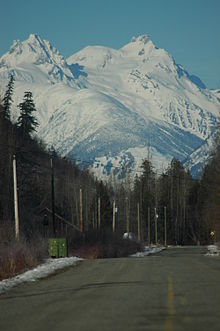- Mount Meager
-
Mount Meager 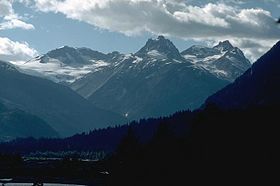
The Mount Meager volcanic complex rising above the Pemberton Valley. Summits left to right are Capricorn Mountain, Mount Meager proper and Plinth Peak.Elevation 2,680 m (8,793 ft) Location British Columbia, Canada Range Pacific Ranges Coordinates 50°38′0″N 123°30′0″W / 50.633333°N 123.5°WCoordinates: 50°38′0″N 123°30′0″W / 50.633333°N 123.5°W Topo map NTS 92J/12 Geology Type Complex volcano Volcanic arc/belt Cascade Volcanic Arc Garibaldi Volcanic Belt Last eruption 410 BC ± 200 years[1] Mount Meager, originally known as Meager Mountain, is a complex volcano in the Sea-to-Sky Corridor of southwestern British Columbia, Canada. It is located 150 km (93 mi) north of Vancouver at the northern end of the Pemberton Valley. Part of the Cascade Volcanic Arc of western North America, its summit is 2,680 m (8,790 ft) above sea level, and is capped by several eroded volcanic edifices. This includes mounds of viscous lava, columns of volcanic rock and overlapping piles of lava flows. Hydrothermal exploration is present at Mount Meager and it is one of the several geothermal sites in British Columbia.
Mount Meager is responsible for the largest volcanic eruption in Canada in the past 10,000 years. About 2,350 years ago, an explosive eruption formed a volcanic crater on its northeastern flank and sent avalanches of hot ash, rock fragments and volcanic gases down the northern flank of the volcano, creating a geological formation in the Lillooet River valley. Evidence for more recent volcanic activity has been documented at the volcano, such as hot springs and earthquakes. Mount Meager has also been the source for several large landslides in the past, including a massive debris flow in 2010 that swept down Meager Creek and the Lillooet River.
The Garibaldi Volcanic Belt has a long history of eruptions and poses a threat to the surrounding region. Any volcanic hazard—ranging from landslides to eruptions—could pose a significant risk to humans and wildlife. Even though Mount Meager has not erupted for over 2,000 years, it could again produce a major eruption; if this were to happen, relief efforts would probably be quickly organized. Teams such as the Interagency Volcanic Event Notification Plan (IVENP) are prepared to notify people threatened by volcanic eruptions.
Contents
Geography and geology
Regional setting
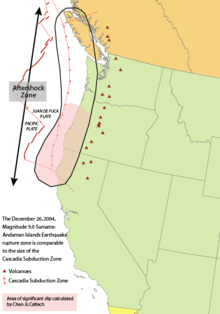 Area of the Cascadia subduction zone, with Mount Meager being the northernmost red triangle in the Cascade Volcanic Arc.
Area of the Cascadia subduction zone, with Mount Meager being the northernmost red triangle in the Cascade Volcanic Arc.
Volcanism in the Cascade Volcanic Arc is caused by subduction of the Juan de Fuca Plate under the North American Plate at the Cascadia subduction zone.[2] This is a 1,094 km (680 mi) long fault zone running 80 km (50 mi) off the Pacific Northwest from Northern California to southwestern British Columbia. The plates move at a relative rate of over 10 mm (0.39 in) per year at an oblique angle to the subduction zone. Because of the very large fault area, the Cascadia subduction zone can produce large earthquakes of magnitude 7.0 or greater. The interface between the Juan de Fuca and North American plates remains locked for periods of roughly 500 years. During these periods, stress builds up on the interface between the plates and causes uplift of the North American margin. When the plate finally slips, the 500 years of stored energy are released in a massive earthquake.[3]
Unlike most subduction zones worldwide, there is no deep oceanic trench present along the continental margin in Cascadia.[4] The reason is that the mouth of the Columbia River empties directly into the subduction zone and deposits silt at the bottom of the Pacific Ocean, burying the oceanic trench. Massive floods from prehistoric Glacial Lake Missoula during the Late Pleistocene also deposited large amounts of sediment into the trench.[5] However, in common with other subduction zones, the outer margin is slowly being compressed, similar to a giant spring.[3] When the stored energy is suddenly released by slippage across the fault at irregular intervals, the Cascadia subduction zone can create very large earthquakes, such as the magnitude 9.0 Cascadia earthquake on January 26, 1700.[6] However, earthquakes along the Cascadia subduction zone are fewer than expected and there is evidence of a decline in volcanic activity over the past few million years. The probable explanation lies in the rate of convergence between the Juan de Fuca and North American plates. These two tectonic plates currently converge 3 cm (1.2 in) to 4 cm (1.6 in) per year. This is only about half the rate of convergence from seven million years ago.[4]
Local setting
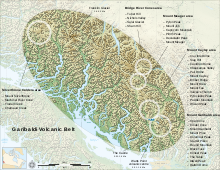 The location and extent of the Garibaldi Volcanic Belt, showing its isolated volcanoes and related volcanic features
The location and extent of the Garibaldi Volcanic Belt, showing its isolated volcanoes and related volcanic features
Mount Meager is part of the Garibaldi Volcanic Belt, an extension of the Cascade Volcanic Arc, which extends from the Watts Point volcano in the south to the Silverthrone Caldera in the north.[7][8] This volcanic belt includes cinder cones, calderas, stratovolcanoes and subglacial volcanoes that have been active in the Holocene period (10,000 years ago to present).[9][10][11][12] The latest explosive eruption in the Garibaldi Volcanic Belt occurred at a crater on the northeastern flank of Mount Meager, which forms a clearly-defined depression.[13][14] At least eight volcanic vents constitute Meager, which erupted mafic, intermediate and felsic magma.[15] Streams and glaciers have played a significant role in dissecting the massif and its upper slopes are covered by snow and ice.[16] Numerous feeder dikes to older units are exposed by deep erosion.[15] Perkin's Pillar, a vertical tower of brecciated lava, represented an erosional remnant of Meager until its collapse in June 2005.[13] More than 10 streams drain meltwater from Mount Meager, including Capricorn Creek, Job Creek, No Good Creek, Angel Creek, Devastation Creek, Canyon Creek and Affliction Creek.[16]
The geomorphology of Mount Meager is similar to Glacier Peak, another Cascade Arc volcano, located in the U.S. state of Washington.[13] It consists of at least four overlapping stratovolcanoes that become progressively younger from south to north.[15] As a result, Meager can be classified as a compound/complex volcano, which consists of two or more vents.[17] With a total volume of 20 km3 (4.8 cu mi), Mount Meager is a long-lived feature, tracing its history back to 2,200,000 years ago.[15][13] This indicates that it is relatively old compared to most volcanoes in the Cascade Arc. In the Cascade Range, the oldest volcanoes are generally no more than a million years old.[18] This includes Mount Rainier (500,000 years),[19] Lassen Peak (27,000 years),[20] Mount Jefferson (680,000 years),[21] Mount St. Helens (50,000 years)[22] and many more.[18] However, portions of Mount Meager formed in the past million years.[23] The volcano is made of volcanic rocks ranging from rhyodacite to basalt. Rhyodacite forms a series of eroded volcanic plugs, which represent the highest peaks of Meager. Their flanks are covered by their eruptive products and are the surface expressions of intrusions. As a result, they provide a unique opportunity to study the relationships between magma chambers and their lavas.[15]
Although some scientists speculate the Silverthrone Caldera as the northernmost volcano of the Garibaldi Volcanic Belt, others prefer Mount Meager as the northernmost.[24][15] This controversy is because little is known about the volcanoes north of Meager, such as Silverthrone and the Franklin Glacier volcanic complex.[25][10] It is also unclear whether the Milbanke Sound Cones are part of the Garibaldi Belt or they are volcanoes formed by different tectonic processes than those in the Garibaldi Belt.[26] However, there is evidence the Silverthrone and Franklin Glacier complexes are related to Cascadia subduction. Geologically, these two volcanoes contain the same rock types as those found elsewhere in the Cascade Arc, including rhyolites, dacites, andesites and basaltic andesites. Such rock types are produced by subduction zone volcanism, indicating volcanism at Silverthrone and Franklin Glacier is probably related to subduction. If these two volcanoes are true Cascade Arc volcanoes, Mount Meager is not the northernmost volcano of the Garibaldi Belt or the Cascade Arc.[27]
A number of summits constitute the Mount Meager massif. The highest and northernmost is Plinth Peak with an elevation of 2,680 m (8,790 ft).[28][29] Mount Meager itself is 2,650 m (8,690 ft) in elevation.[29] Capricorn Mountain west of Mount Meager proper rises with an elevation of 2,570 m (8,430 ft). Mount Job, 2,493 m (8,179 ft), is situated just west of Capricorn Mountain.[28][29] Pylon Peak with an elevation of 2,481 m (8,140 ft) is south of Capricorn Mountain and Mount Meager proper.[29] Devastator Peak, also known as The Devastator, has an elevation of 2,315 m (7,595 ft) and is the lowest and southernmost summit of Mount Meager.[28][29]
Bridge River Vent
The Bridge River Vent is a relatively young volcanic crater that formed during an eruption about 2,350 years ago.[30][31] This eruption ranged in character from explosive to effusive, involving lava dome extrusion, pyroclastic flows, lahars and lava flows.[1] Eastward migration of the eruption column spread material across Western Canada to deposit the Bridge River Ash. In the Bridge River and Lillooet River area, the ash occurs as a coarse-textured deposit with blocks of pumice up to 10 cm (3.9 in) in diameter. The texture rapidly becomes finer eastward from the Bridge River. At Big Bar on the Fraser River, pellets are up to 3 mm (0.12 in) in diameter while pellets in the Messiter area have a maximum diameter of 0.7 mm (0.028 in).[32]
Situated on the northeastern flank of Plinth Peak, the Bridge River Vent has an elevation of 1,524 m (5,000 ft).[28][31] It has oversteepened walls covered with ice and debris from volcanic activity and slope collapses.[23][31] The crater is roughly bowl-shaped, although it is breached on the northern side.[31] Because the Bridge River Vent is located on the northern flank of Meager, it represents a satellite vent. The eruption that formed the Bridge River Vent was probably fed through a conduit from the magma chamber below Meager. A stress field controlled by regional tectonics has been commonly invoked to explain the dynamics of lateral flow of magma from a reservoir to produce such eruptions.[33]
Climate and vegetation
Mount Meager is situated in the Coast Mountains, a 1,600 km (990 mi) long mountain range extending from Vancouver to the Alaskan Panhandle.[23][34] It is about 300 km (190 mi) wide, cut by fjords created by glacial erosion. Because the Coast Mountains are just east of the Pacific Ocean, they have a profound effect on British Columbia's climate by forcing moisture-laden air off the ocean. This drops heavy rainfalls on the western slopes where lush forests exist. The precipitation is among the heaviest in North America.[34]
Valleys surrounding Mount Meager contain old-growth forests. The area also has wetland habitats, plants of the cottonwood-willow-thimbleberry family and glaucous willowherbs. Wildlife such as wolves, wolverine, moose, raptors, black-tailed deer, mountain goats and waterfowl inhabit the area, as well as grizzly and black bears.[35]
Human history
Naming
The name Meager Mountain was adopted on May 6, 1924 as labelled on the 1923 British Columbia map 2D. In 1966, the volcano was renamed to Mount Meager. According to a letter written in March 1983, "the local name, Cathedral, was duplicated elsewhere, so the mountain was renamed Meager after the creek of that name which lies to the south of it". Meager Creek is in turn named after J.B. Meager, who was an owner of timber licences on the creek.[36] Despite its official name, Mount Meager is sometimes mistakenly spelled Mount Meagre or Mount Meagher.[37]
Meager's subsidiary peak names were submitted by Canadian mountaineer Neal M. Carter, who was a member of the British Columbia Mountaineering Club. Devastator Peak was officially named on August 3, 1977 in association with Devastation Glacier.[38] Plinth Peak was officially named on September 6, 1951 as identified in Carter's 1932 sketch map and article "Explorations in the Lillooet River Watershed".[39] Mount Job and Pylon Peak were both officially named on January 17, 1957 as labelled on Carter's 1954 sketch map of the Lillooet River.[40][41] Capricorn Mountain was originally identified as Mount Capricorn in the 1932 Canadian Alpine Journal, Vol XXI. According to Carter's 1932 Canadian Alpine Journal, Vol XXI, "the name chosen for the 8440-foot mountain was Mt. Capricorn, a variation of the all-too-common appellation "Goat Mountain", applied by Bert [Perkins] to the stream which drains the Capricorn glacier at its base". Subsequently, the peak was renamed to Capricorn Mountain on June 22, 1967.[42]
Occupation
A large pumice outcrop more than 2,000 m (6,600 ft) long and 1,000 m (3,300 ft) wide has been the subject of mining operations since at least the 1970s. The deposit was first hired by J. MacIsaac, who died in the late 1970s. In the mid 1970s the second hirer, W.H. Willes, investigated and mined the pumice. It was crushed, removed then stored close to the village of Pemberton. Later, the bridge that was used to access the pumice deposit was washed out and mining operations were not renewed. Mining resumed in 1988 when the deposit was staked by L.B. Bustin. In 1990, the pumice outcrop was bought by D.R. Carefoot from the owners B. Chore and M. Beaupre. In a program from 1991 to 1992, workers evaluated the deposit for its properties as a construction material and as an absorber for oil and stonewash. About 7,500 m3 (260,000 cu ft) of pumice was mined in 1998 by the Great Pacific Pumice Incoporation.[43]
Mount Meager has been investigated as a potential hydrothermal energy resource. At least 16 geothermal sites have been identified in British Columbia, the Mount Meager area being one of the five areas most capable for commercial development. Others include the Lakelse Hot Springs near the community of Terrace, Mount Cayley near the community of Squamish, Mount Edziza on the Tahltan Highland and the Lillooet Fault Zone between Harrison Lake and the community of Lillooet. At Meager Creek, there is potential for commercial development of a 100-200 megawatt power station. Nearby Pebble Creek also has "very good" potential for a 200 megawatt plant.[44] Because the two creeks offer the greatest potential for commercial development, the Mount Meager area is the most promising site for geothermal power development in British Columbia.[44][28]
Volcanic history
Mount Meager and the nearby Elaho Valley volcanic complex collectively have erupted 54 times in the past 2,600,000 years.[45] Effusive and explosive eruptions have occurred throughout Meager's 2,200,000 year eruptive history.[15][14][13] Four primary eruptive periods in the history of Mount Meager have been identified, with individual eruptions separated by thousands of years.[15][45] Large northwest-southeast trending structures paralleling Harrison Lake and the Pemberton Valley may control volcanic activity at Mount Meager or at least create zones of crustal weakness that are exploited by rising magma batches.[13]
First record of activity
During the first eruptive period 2,200,000 to 1,900,000 years ago, intermediate to felsic pyroclastic rocks were erupted at the southern end of the massif.[15][24] Basal breccia, which may be an exhumed vent, underlies andesite and tuffs, flows, lava domes and breccia of Devastator Peak.[24] It has a maximum thickness of 300 m (980 ft) and overlies a 400 m (1,300 ft) high ridge of bedrock that formed between 251,000,000 and 65,500,000 years ago of the Mesozoic era.[23]
At the southwestern end of Meager, dacite with sparse phenocrysts of quartz, plagioclase and hornblende, represents a 200 m (660 ft) thick remnant of subhorizontal lava flows.[23]
The Devastator and Pylon assemblage eruptive periods
The second eruptive period between 1,900,000 and 500,000 years ago produced rhyodacite tuff, breccia, lavas and domes of The Devastator Assemblage.[15][24] This 500 m (1,600 ft) thick geological formation is located on the south and west flanks of Pylon Peak and Devastator Peak. Its western portion consists of roughly layered tephra while its eastern end represents the lava flows and subvolcanic intrusions of a partly preserved vent. Here, The Devastator Assemblage is massive and steeply truncates basal breccia from the first eruptive period.[23]
Between 1,000,000 and 500,000 years ago, a thick sequence of andesite lava flows were erupted from the volcanic plug of Devastator Peak, creating the Pylon Assemblage.[15][24] With a maximum thickness of over 1 km (0.62 mi), the Pylon Assemblage is the largest rock unit comprising Mount Meager.[14][24] The lava flows are normally layered, separated by a thin layer of lapilli tuff and reddened breccia. A concentration of subvolcanic intrusions and coarse volcanic breccia clasts over 100 m (330 ft) in length suggest that Devastator Peak is a major vent.[23]
Formation of the Plinth, Job, Capricorn and Mosaic assemblages
The fourth and final eruptive period 150,000 to less than 3,000 years ago produced rhyodacite lava flows, domes, breccias and subvolcanic intrusions of the Plinth, Job and Capricorn assemblages.[24][15] Around Mount Job, porphyritic hornblende, biotite and quartz rhyodacite lava flows of the Job Assemblage were erupted. They are prominently layered and locally columnar jointed. On the east side of Affliction Glacier, they overlie porphyritic andesite lava flows of the Pylon Assemblage. Later, rhyodacite lava flows of the Capricorn Assemblage were erupted and flowed over biotite rhyodacite of the Job Assemblage. The upper 600 m (2,000 ft) of Capricorn Mountain and Mount Job are formed by these lava flows.[23]
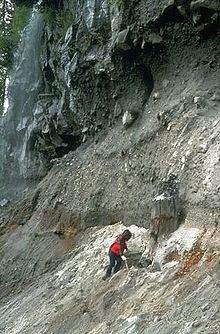 A geologist next to a tree trunk that was buried by ash-fall deposits and then overrun by a pyroclastic flow from the Bridge River Vent eruption about 2,350 years ago.
A geologist next to a tree trunk that was buried by ash-fall deposits and then overrun by a pyroclastic flow from the Bridge River Vent eruption about 2,350 years ago.
Another sequence of rhyodacite lava flows were subsequently erupted and form the Plinth Assemblage. Mount Meager proper, a massive lava dome or volcanic plug, consists of steeply inclined flow layering and was the southern source of Plinth Assemblage lava flows and breccias. Plinth Peak was also formed during the Plinth Assemblage eruptive stage and is mostly composed of prominent columnar or partly jointed lava flows. Its north ridge and flat-topped summit contain three areas of steep flow layering and subhorizontally-oriented columnar jointing. These areas are possibly the remains of volcanic plugs or lava domes that were the northern source of Plinth Assemblage lava flows.[23] The Mosaic Assemblage, a sparsely porphyritic plagioclase-augite-olivine basalt and trachybasalt formation, also formed during the fourth eruptive period. It is the remains of scoriaceous lava flows, breccias, volcanic bombs and pillow lavas.[24][23]
The best known and most documented eruption of Mount Meager is a large explosive eruption that occurred about 2,350 years ago.[16] This eruption, which likely reached 5 on the Volcanic Explosivity Index (VEI), was similar to the 1980 eruption of Mount St. Helens.[1][46] It sent a massive Plinian column at least 20 km (12 mi) high into the atmosphere. Prevailing winds carried volcanic ash from this explosion eastwards to as far as Alberta. Nearby areas were devastated by heavy pyroclastic fall when parts of the Plinian column collapsed. Later, a series of pyroclastic flows were erupted and travelled 7 km (4.3 mi) from their source. After this happened, a lava flow was erupted that repeatedly collapsed on Meager's steep flanks, creating a thick welded breccia deposit that blocked the Lillooet River. This created a lake just upstream and later collapsed to produce a massive outburst flood. Large boulders were carried downstream for over 2 km (1.2 mi), but the destructive floodwaters continued further. After this took place, a small dacite lava flow was erupted, which cooled into well preserved columnar joints.[14] The entire eruption cycle was erupted from the Bridge River Vent on the northeastern flank of Plinth Peak.[1][31] This is the latest known eruption of Mount Meager, as well as the largest known Holocene explosive eruption in Canada.[47] However, it is unknown when this eruption ended.[1]
In 1977, J. A. Westgate of the University of Toronto suggested that a smaller eruption may have occurred at the Bridge River Vent after the eruption 2,350 years ago, sending tephra to the southeast. A tephra deposit overlying the Bridge River Ash at Otter Creek shows strong genetic relationships with the Bridge River Ash, differing only by its absence of biotite. In earlier publications, this tephra is classified as part of the Bridge River Ash. However, it has been dated to be about 2,000 radiocarbon years old, indicating that this tephra is a few hundred years younger than the Bridge River Ash. Apparent absence of biotite and occurrence well to the south of the Bridge River Ash likewise favour a separate identity.[48] Large volume, fine grained, debris flows north of the volcano might have been caused by volcanic activity. If this is correct, the knowledge of eruptions at Mount Meager in the past 10,000 years is insufficient.[13]
Recent activity
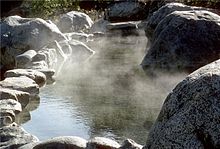 A volcanic hot spring near Meager Creek related to volcanism at Mount Meager. This hot spring lies in one of the few hot spring clusters near Meager.
A volcanic hot spring near Meager Creek related to volcanism at Mount Meager. This hot spring lies in one of the few hot spring clusters near Meager.
Two small hot spring clusters are found at Mount Meager, indicating magmatic heat is still present.[14] These two clusters of hot springs, known as the Meager Creek Hot Springs and Pebble Creek Hot Springs, are most likely related to recent volcanic activity at Mount Meager.[29][28] Meager Creek Hot Springs, the largest in British Columbia, remain free of snow for most of the year.[29][49] The springs at Mount Meager might be evidence of a shallow magma chamber beneath the surface.[50]
Between 1970 and 2005, over 20 small earthquakes were recorded at the volcano. The magnitude of these events were generally no higher than 2.0 on the Richter magnitude scale and they originated 20 km (12 mi) to less than 1 km (0.62 mi) below the surface.[16] Other volcanoes in the Garibaldi Volcanic Belt with recorded seismicity include Mount Garibaldi, Mount Cayley and Silverthrone Caldera.[51] Seismic data suggest that these volcanoes still contain active magma chambers, indicating that some Garibaldi Belt volcanoes are probably active, with significant potential hazards.[52][51] The seismic activity corresponds with some of Canada's recently formed volcanoes and with persistent volcanoes that have had major explosive activity throughout their history, such as Mount Garibaldi, Mount Cayley and Mount Meager.[51]
Threats and preparedness
Eruptions
Because Mount Meager is capable of producing highly explosive eruptions, it is, overall, a dangerous volcano. Many populated areas throughout southern British Columbia and Alberta are threatened by Mount Meager. Pemberton, a community some 50 km (31 mi) downstream from Meager, is also significantly threatened by the volcano.[14] Because of these concerns, the Geological Survey of Canada is planning to create hazard maps and emergency plans for Mount Meager, as well as Mount Cayley to the south.[52] If the volcano were to erupt again violently, it would have large-scale effects on the Lillooet River fishery. Another significant eruption would also have massive effects on nearby mining and logging activity.[14] In addition, Mount Meager is situated in the immediate proximity of a major air traffic route.[53] Volcanic ash reduces visibility and can cause jet engine failure, as well as damage to other aircraft systems.[54]
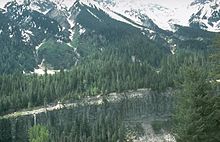 A pyroclastic flow deposit forming the foreground canyon wall on the Lillooet River. It was erupted from the Bridge River Vent on the northeastern flank of Plinth Peak.
A pyroclastic flow deposit forming the foreground canyon wall on the Lillooet River. It was erupted from the Bridge River Vent on the northeastern flank of Plinth Peak.
Jack Souther, a leading authority on geothermal resources and volcanism in the Canadian Cordillera, has stated "at present the volcanoes of the Garibaldi Belt are quiet, presumed dead but still not completely cold. But the flare-up of Meager Mountain 2,500 years ago raises the question, "Could it happen again?" Was the explosive eruption of Meager Mountain the last gasp of the Garibaldi Volcanic Belt or only the most recent event in its on-going life? The short answer is nobody really knows for sure. So just in case I sometimes do a quick check of the old hot-spots when I get off the Peak Chair".[55]
Even though very few eruptions in Canada have been witnessed by people, Canada is geologically an area of intense volcanic activity. According to the Geologic Hazards '91 Workshop, "priority should be given to eruption impact studies of the two recently active volcanic centres closest to urban areas, Mount Baker and Mount Meager. The former case will require a combined US-Canada-Washington State-B.C. effort".[45] In addition, Mount Meager is not monitored closely enough by the Geological Survey of Canada to ascertain how active its magma system is.[56] If it were to erupt, relief efforts could be orchestrated. The Interagency Volcanic Event Notification Plan (IVENP) was created to outline the notification procedure of some of the main agencies that would be involved in response to an erupting volcano in Canada, an eruption close to the Canada – United States border or any eruption that will have effects in Canada.[57]
Although Mount Meager is a potentially active volcano, as of 2003 there was no evidence of an imminent eruption. Many shallow earthquakes normally occur before a volcano erupts. As magma rises to the surface, it will probably create much more vigour and heat at the regional hot springs, as well as the formation of new springs or fumaroles. These signs generally occur well in advance of a potential eruption, although the possibility of an eruption occurring in the near future is low.[58]
Landslides
Mount Meager has been the source for many large landslides in the past 8,000 years. These have flowed down the Lillooet River valley to areas that have become populated in the past 100 years and are now experiencing rapid urban growth. For example, the town of Pemberton has doubled in size since 2003. In addition, it has been argued by scientists that Mount Meager is the most unstable mountain massif in Canada.[16] It may also be the most active landslide area in Canada.[59] Because Mount Meager is capable of producing large landslides, Meager Creek valley is probably the most dangerous valley in the Canadian Cordillera. Debris flows, mainly from Mount Meager, have filled the valley to a depth of 250 m (820 ft).[23]
Volcano-associated debris flows, known as lahars, are one of the most dangerous hazards associated with volcanoes. They can occur both during an eruption and when a volcano is not erupting. The water that creates lahars can come from melting snow and ice, intense rainfall or the breakout of a summit crater lake. Large lahars are a potential hazard to many communities downstream from glaciated volcanoes.[60] In addition, Pemberton is vulnerable to lahars from Mount Meager.[14] Lahars are also a major hazard at Mount Rainier, a younger but heavily glaciated stratovolcano southeast of Seattle in the central Cascade Volcanic Arc.[60][61][15] More than 25 landslides have occurred at Mount Meager in the past 8,000 years.[16]
Prehistoric
Event Source Age[note 1] Reference Rock avalanche/debris flow Pylon Peak 7900 Friele and Clague (2004)[16] Rock avalanche/debris flow Job Creek 6250 Friele et al. (2005)[16] Rock avalanche/debris flow Capricorn Creek 5250 McNeely and McCuaig (1991)[16] Rock avalanche/debris flow/hyperconcentrated flow Pylon Peak 4400 Friele and Clague (2004); Friele et al. (2005)[16] Rock avalanche/debris flow Job Creek, eruption precursor 2600 Friele et al. (2005); Simpson et al. (2006)[16] Pyroclastic flow Syn-eruptive 2400 Stasiuk et al. (1996); Stewart (2002)[16] Rock avalanche/outburst flood/debris flow/hyperconcentrated flow Syn-eruptive 2400 Stasiuk et al. (1996); Stewart (2002)[16] Rock avalanche Syn- to post-eruptive 2400 Stasiuk et al. (1996); Stewart (2002)[16] Debris flow Job Creek 2240 Pierre, Jakob and Clague (2008)[16] Debris flow Devastation Creek 2170 McNeely and McCuaig (1991)[16] Debris flow Angel Creek 1920 McNeely and McCuaig (1991)[16] Debris flow Job Creek 1860 McNeely and McCuaig (1991)[16] Debris flow Job Creek 870 Jordan (1994)[16] Debris flow No Good Creek 800 McNeely and McCuaig (1991)[16] Debris flow Job Creek 630 Pierre, Jakob and Clague (2008)[16] Debris flow No Good Creek 370 McNeely and McCuaig (1991)[16] Debris flow Angel Creek 210 McNeely and McCuaig (1991)[16] Historic
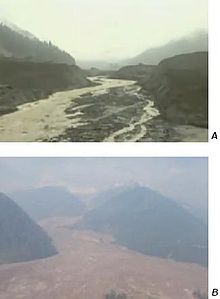 River valleys filled with debris from the 2010 landslide of Mount Meager. Photo A is the collapsed debris dam near the intersection of Capricorn Creek and Meager Creek. Photo B is the debris flow at the junction of Meager Creek and the Lillooet River.
River valleys filled with debris from the 2010 landslide of Mount Meager. Photo A is the collapsed debris dam near the intersection of Capricorn Creek and Meager Creek. Photo B is the debris flow at the junction of Meager Creek and the Lillooet River.
Event Source Age[note 2] Reference Debris flow Devastation Creek 1931 Carter (1931); Decker et al. (1977); Jordan (1994)[16] Rock avalanche Capricorn Creek <100 years Croft (1983)[16] Rock avalanche Devastation Creek 1947 Read (1978)[16] Debris flow Capricorn Creek 1972 Jordan (1994)[16] Rock avalanche Devastation Creek 1975 Mokievsky-Zubot (1977); Evans (2001)[16] Debris flow Affliction Creek 1984 Jordan (1994)[16] Rock avalanche Mount Meager 1986 Evans (1987)[16] Debris flow Capricorn Creek 1998 Bovis and Jakob (2000)[16] Debris flow Capricorn Creek 2010 McKinnon (2010)[62] 2010 landslide
On August 6, 2010, a massive lahar cascaded down from Capricorn Glacier with a speed of 30 m (98 ft) per second.[63] With a volume of 40,000,000 m3 (1.4×109 cu ft), it is the second largest landslide in Canadian history, exceeded by the Hope Slide, which removed 47,000,000 m3 (1.7×109 cu ft) of rock from Johnson Peak.[64][63] The 2010 landslide at Mount Meager was 300 m (980 ft) wide and 2 km (1.2 mi) long, creating a dam across Meager Creek and the Lillooet River. This resulted in the creation of a lake just upstream. Fears of the dam collapsing and flooding the Lillooet River valley ended a day after the landslide when part of the dam ruptured and slowly released water. An evacuation alert was rescinded and nearly 1,500 residents were allowed to return to their homes on the weekend after the landslide occurred. No injuries were reported from this landslide.[63]
See also
- List of volcanoes in Canada
- List of Cascade volcanoes
- Volcanism of Western Canada
Notes
- ^ Radiocarbon age in 14C year (Before Present). The cited ages are those that most closely constrain the age of the event.[16]
- ^ Age in calendar years. The cited years are those when the event took place.[16]
References
 This article incorporates public domain material from websites or documents of the United States Geological Survey.
This article incorporates public domain material from websites or documents of the United States Geological Survey.- ^ a b c d e "Meager: Eruptive History". Global Volcanism Program, Smithsonian Institution. http://www.volcano.si.edu/world/volcano.cfm?vnum=1200-18-&volpage=erupt. Retrieved 2011-07-14.
- ^ Gillespie, Alan R.; Porter, Stephen C.; Atwater, Brain F. (2004). The Quaternary period in the United States. Elsevier Ltd.. p. 351. ISBN 0-444-51471-6.
- ^ a b "Cascadia Subduction Zone". Geodynamics. Natural Resources Canada. 2008-01-15. http://gsc.nrcan.gc.ca/geodyn/cascadia_e.php. Retrieved 2010-03-06.
- ^ a b "Pacific Mountain System – Cascades volcanoes". United States Geological Survey. 2000-10-10. http://www.nature.nps.gov/geology/usgsnps/province/cascade2.html. Retrieved 2010-03-05.
- ^ Dutch, Steven (2003-04-07). "Cascade Ranges Volcanoes Compared". University of Wisconsin. http://www.uwsp.edu/geo/projects/geoweb/participants/dutch/VTrips/CascadesComp.HTM. Retrieved 2010-05-21.
- ^ "The M9 Cascadia Megathrust Earthquake of January 26, 1700". Natural Resources Canada. 2010-03-03. http://earthquakescanada.nrcan.gc.ca/histor/15-19th-eme/1700/1700-eng.php. Retrieved 2010-03-06.
- ^ "Garibaldi volcanic belt". Catalogue of Canadian volcanoes. Natural Resources Canada. 2009-04-02. http://gsc.nrcan.gc.ca/volcanoes/cat/belt_garibaldi_e.php. Retrieved 2010-07-06.
- ^ "Garibaldi Volcanic Belt". Map of Canadian volcanoes. Natural Resources Canada. 2005-08-20. http://gsc.nrcan.gc.ca/volcanoes/map/map_e.php?id=gvb. Retrieved 2010-07-06.
- ^ "Opal Cone". Catalogue of Canadian volcanoes. Natural Resources Canada. 2009-03-10. http://gsc.nrcan.gc.ca/volcanoes/cat/volcano_e.php?id=gvb_ocn_007. Retrieved 2010-07-06.
- ^ a b "Silverthrone Caldera". Catalogue of Canadian volcanoes. Natural Resources Canada. 2009-03-10. http://gsc.nrcan.gc.ca/volcanoes/cat/volcano_e.php?id=gvb_scl_044. Retrieved 2010-07-06.
- ^ "Mount Price". Catalogue of Canadian volcanoes. Natural Resources Canada. 2009-03-10. http://gsc.nrcan.gc.ca/volcanoes/cat/volcano_e.php?id=gvb_mpc_009. Retrieved 2010-07-06.
- ^ "Cauldron Dome". Catalogue of Canadian volcanoes. Natural Resources Canada. 2009-03-10. http://gsc.nrcan.gc.ca/volcanoes/cat/volcano_e.php?id=gvb_cdm_023. Retrieved 2010-07-06.
- ^ a b c d e f g Monger, J.W.H. (1994). "Character of volcanism, volcanic hazards, and risk, northern end of the Cascade magmatic arc, British Columbia and Washington State". Geology and Geological Hazards of the Vancouver Region, Southwestern British Columbia. Natural Resources Canada. pp. 231, 241, 242. ISBN 0-660-15784-5.
- ^ a b c d e f g h "Garibaldi volcano belt: Mount Meager volcanic field". Catalogue of Canadian volcanoes. Natural Resources Canada. 2009-04-01. http://gsc.nrcan.gc.ca/volcanoes/cat/feature_meager_e.php. Retrieved 2011-07-06.
- ^ a b c d e f g h i j k l m Wood, Charles A.; Kienle, Jürgen (2001). Volcanoes of North America: United States and Canada. Cambridge, England: Cambridge University Press. pp. 113, 141, 149. ISBN 0-521-43811-X.
- ^ a b c d e f g h i j k l m n o p q r s t u v w x y z aa ab ac ad ae af ag Friele, Pierre; Jakob, Matthias; Clague, John (2008). "Georisk: Assessment and Management of Risk for Engineered Systems and Geohazards". Hazard and risk from large landslides from Mount Meager volcano, British Columbia, Canada (Taylor & Francis) 2 (1): 48, 49, 50, 56. ISSN 1749-9518.
- ^ Ghos, Ajay Kumar (2005). Dictionary of Geology. Isha Books. p. 52. ISBN 81-8205-216-5.
- ^ a b Smoot, Jeff (1999). Climbing the Cascade Volcanoes. Globe Pequot Press. p. 9. ISBN 1-56044-889-X.
- ^ Aleshire, Peter (2008). Mountains. Infobase Publishing. p. 97. ISBN 0-8160-5918-7.
- ^ Blinkhorn, Earl F. (2004). The Ring of Fire. Trafford Publishing. p. 164. ISBN 1-4120-2170-7.
- ^ Wuerthner, George (2003). Oregon's Wilderness Areas: The Complete Guide. Westcliffe Publishers. p. 123. ISBN 1-56579-434-6.
- ^ Campbell, Ballard C. (2008). Disasters, Accidents, and Crises in American History: A Reference Guide to the Nation's Most Catastrphic Events. Infobase Publishing. p. 370. ISBN 0-8160-6603-5.
- ^ a b c d e f g h i j k Read, Peter B. (1990). "Mount Meager Complex, Garibaldi Belt, Southwestern British Columbia". Articles (Geological Association of Canada) 17 (3): 167, 168, 169, 170. ISSN 1911-4850.
- ^ a b c d e f g h Stelling, Pete; Tucker, David S. (2007). Floods, Faults, and Fire: Geological Field Trips in Washington State and Southwest British Columbia. Boulder, Colorado: Geological Society of America. pp. 2, 14, 15. ISBN 978-0-8137-0009-0.
- ^ "Flanklin Glacier". Catalogue of Canadian volcanoes. Natural Resources Canada. 2009-03-10. http://gsc.nrcan.gc.ca/volcanoes/cat/volcano_e.php?id=gvb_fgl_006. Retrieved 2011-11-04.
- ^ "Anahim Volcanic Belt: Milbanke Sound cones". Catalogue of Canadian volcanoes. Natural Resources Canada. 2009-04-14. http://gsc.nrcan.gc.ca/volcanoes/cat/feature_milbanke_e.php. Retrieved 2011-11-04.
- ^ Blakes, Stephen; Argles, Tom (2003). Growth and Destruction: Continental evolution at subduction zones. The Open University. p. 55. ISBN 0-7492-5666-4.
- ^ a b c d e f "Meager: Synonyms and Subfeatures". Global Volcanism Program, Smithsonian Institution. http://www.volcano.si.edu/world/volcano.cfm?vnum=1200-18-&volpage=synsub. Retrieved 2011-07-03.
- ^ a b c d e f g Jessop, A. (2008), Geological Survey of Canada, Open File 5906, Natural Resources Canada, pp. 33, 35
- ^ "Bridge River Vent". Catalogue of Canadian volcanoes. Natural Resources Canada. 2009-03-10. http://gsc.nrcan.gc.ca/volcanoes/cat/volcano_e.php?id=gvb_brv_033. Retrieved 2011-10-09.
- ^ a b c d e "Meager: Photo Gallery". Global Volcanism Program, Smithsonian Institution. http://www.volcano.si.edu/world/volcano.cfm?vnum=1200-18-&volpage=photos. Retrieved 2011-07-14.
- ^ Nasmith, H.; Mathews, W. H.; Rouse, G. E. (1967). "Bridge River Ash and Some Other Recent Ash Beds in British Columbia". Canadian Journal of Earth Sciences. 4. NRC Research Press. pp. 163, 164. ISSN 0008-4077.
- ^ Acocella, V.; Neri, M. (2003). What makes flank eruptions? The 2001 Etna eruption and its possible triggering mechanisms. Springer-Verlag. p. 518.
- ^ a b "Coast Mountains". BC Geographical Names. http://apps.gov.bc.ca/pub/bcgnws/names/21188.html. Retrieved 2011-07-02.
- ^ "Upper Lillooet Provincial Park". BC Parks. http://www.env.gov.bc.ca/bcparks/explore/parkpgs/up_lillooet/. Retrieved 2011-07-20.
- ^ "Mount Meager". BC Geographical Names. http://apps.gov.bc.ca/pub/bcgnws/names/34788.html. Retrieved 2011-07-06.
- ^ E.C. (1986). Ground water supply - Fraser Lowland, British Columbia. Saskatoon, Saskatchewan: National Hydrology Research Institute. p. 60. ISBN 0-662-15086-4.
- ^ "Devastator Peak". BC Geographical Names. http://apps.gov.bc.ca/pub/bcgnws/names/14555.html. Retrieved 2011-07-06.
- ^ "Plinth Peak". BC Geographical Names. http://apps.gov.bc.ca/pub/bcgnws/names/16912.html. Retrieved 2011-07-06.
- ^ "Mount Job". BC Geographical Names. http://apps.gov.bc.ca/pub/bcgnws/names/26264.html. Retrieved 2011-07-06.
- ^ "Pylon Peak". BC Geographical Names. http://apps.gov.bc.ca/pub/bcgnws/names/21386.html. Retrieved 2011-07-06.
- ^ "Capricorn Mountain". BC Geographical Names. http://apps.gov.bc.ca/pub/bcgnws/names/11155.html. Retrieved 2011-07-06.
- ^ "Mount Meager, Lillooet River Pumice, Pum, Great Pacific, Mt. Meager Pumice". MINFILE Mineral Inventory. Government of British Columbia. 1998-12-04. http://minfile.gov.bc.ca/Summary.aspx?minfilno=092JW+040. Retrieved 2010-03-16.
- ^ a b (PDF) BC Hydro Green & Alternative Energy Division. BC Hydro. 2002. p. 20. http://www.bchydro.com/etc/medialib/internet/documents/environment/pdf/green_energy_study.Par.0001.File.greenenergystudy-summary.pdf. Retrieved 2011-07-20.
- ^ a b c Bobrowsky, Peter (1992). "Geologic Hazards in British Columbia". Volcanic Hazards (Geologic Hazards '91 Workshop): 5, 41, 54. ISSN 0825-3530.
- ^ "Map of Canadian volcanoes". Volcanoes of Canada. Natural Resources Canada. 2008-02-13. http://gsc.nrcan.gc.ca/volcanoes/map/index_e.php. Retrieved 2011-07-14.
- ^ "Meager". Global Volcanism Program, Smithsonian Institution. http://www.volcano.si.edu/world/volcano.cfm?vnum=1200-18-. Retrieved 2011-07-14.
- ^ "Identification and significance of late Holocene tephra from Otter Creek, southern British Columbia, and localities in west-central Alberta". Canadian Journal of Earth Sciences (NRC Research Press) 14: 2595. 1977. ISSN 0008-4077.
- ^ Gardner, Matthew (2008). Western Canada. Footprint Handbooks Ltd.. p. 157. ISBN 978-1-906098-26-1.
- ^ Woodsworth, Glenn J. (April, 2003). Geology and Geothermal Potential of the AWA Claim Group, Squamish, British Columbia. Vancouver, British Columbia: Gold Commissioner's Office. p. 10.
- ^ a b c Etkin, David; Haque, C.E. and Brooks, Gregory R. (2003-04-30). An Assessment of Natural Hazards and Disasters in Canada. Springer. pp. 569, 582, 583. ISBN 978-1402011795.
- ^ a b "Volcanology in the Geological Survey of Canada". Volcanoes of Canada. Natural Resources Canada. 2007-10-10. http://gsc.nrcan.gc.ca/volcanoes/gscvol_e.php. Retrieved 2010-07-06.
- ^ "Volcanic hazards". Volcanoes of Canada. Natural Resources Canada. 2009-04-02. http://cgc.rncan.gc.ca/volcanoes/haz_e.php. Retrieved 2011-07-23.
- ^ Neal, Christina A.; Casadevall, Thomas J.; Miller, Thomas P.; Hendley II, James W.; Stauffer, Peter H. (2004-10-14). "Volcanic Ash–Danger to Aircraft in the North Pacific". United States Geological Survey. http://pubs.usgs.gov/fs/fs030-97/. Retrieved 2011-07-23.
- ^ "CanGEA Honourary Member 2008 Dr. Jack Souther" (PDF). Canadian Geothermal Energy Association. http://www.cangea.ca/images/uploads/Jack_Souther_Biography.pdf. Retrieved 2010-03-04.
- ^ "Monitoring volcanoes". Volcanoes of Canada. Natural Resources Canada. 2009-02-26. http://gsc.nrcan.gc.ca/volcanoes/mon_e.php. Retrieved 2011-06-15.
- ^ "Interagency Volcanic Event Notification Plan (IVENP)". Volcanoes of Canada. Natural Resources Canada. 2008-06-04. http://gsc.nrcan.gc.ca/volcanoes/ivenp_e.php. Retrieved 2011-06-15.
- ^ Simpson, K.A.; Stasiuk, M.V.; Clague, J.J.; Evans, S.G.; Friele, P. (2003). Preliminary drilling results from the Pemberton Valley, British Columbia. Geological Survey of Canada. p. 6. ISSN 1701-4387.
- ^ Knight, J.; Harrison, S. (2009). Periglacial and Paraglacial Processes and Environments. Geological Society of London. p. 229. ISBN 978-1-86239-281-6.
- ^ a b "What Are Volcano Hazards?". United States Geological Survey. 2010-08-24. http://pubs.usgs.gov/fs/fs002-97/. Retrieved 2011-08-18.
- ^ "Rainier". Global Volcanism Program, Smithsonian Institution. http://www.volcano.si.edu/world/volcano.cfm?vnum=1201-03-. Retrieved 2011-08-18.
- ^ McKinnon, Mika (2010-08-31), GeoNatHaz 2010: International Competence in Natural Hazards, The Vancouver Sun, p. 6, ISSN 0832-1299
- ^ a b c Luk, Vivian (2010-08-09), Flooding averted after landslide blocked Meager Creek, The Vancouver Sun, pp. 1, 2, ISSN 0832-1299
- ^ "Photograph of Hope Slide". Natural Resources Canada. 2007-03-27. http://atlas.nrcan.gc.ca/auth/english/maps/environment/naturalhazards/landslides/fig_12_land_hope_slide.jpg/image_view. Retrieved 2011-07-06.
External links
- "Mount Meager". Bivouac.com. http://www.bivouac.com/MtnPg.asp?MtnId=953. Retrieved 2011-07-03.
- "Mount Meager". Geographical Names Data Base. Natural Resources Canada. http://geonames.nrcan.gc.ca/search/unique_e.php?id=JCJGT&output=xml. Retrieved 2011-08-16.
- "Pylon Peak". Bivouac.com. http://www.bivouac.com/MtnPg.asp?MtnId=955. Retrieved 2011-07-03.
- "Pylon Peak". Geographical Names Data Base. Natural Resources Canada. http://geonames.nrcan.gc.ca/search/unique_e.php?id=JBMCJ&output=xml. Retrieved 2011-08-16.
- "Plinth Peak". Bivouac.com. http://www.bivouac.com/MtnPg.asp?MtnId=752. Retrieved 2011-07-03.
- "Plinth Peak". Geographical Names Data Base. Natural Resources Canada. http://geonames.nrcan.gc.ca/search/unique_e.php?id=JBEDD&output=xml. Retrieved 2011-08-16.
- "Mount Job". Bivouac.com. http://www.bivouac.com/MtnPg.asp?MtnId=958. Retrieved 2011-07-03.
- "Mount Job". Geographical Names Data Base. Natural Resources Canada. http://geonames.nrcan.gc.ca/search/unique_e.php?id=JBUVQ&output=xml. Retrieved 2011-08-16.
- "Devastator Peak". Bivouac.com. http://www.bivouac.com/MtnPg.asp?MtnId=956. Retrieved 2011-07-03.
- "Devastator Peak". Geographical Names Data Base. Natural Resources Canada. http://geonames.nrcan.gc.ca/search/unique_e.php?id=JBAAF&output=xml. Retrieved 2011-08-16.
- "Capricorn Mountain". Bivouac.com. http://www.bivouac.com/MtnPg.asp?MtnId=957. Retrieved 2011-07-03.
- "Capricorn Mountain". Geographical Names Data Base. Natural Resources Canada. http://geonames.nrcan.gc.ca/search/unique_e.php?id=JATUN&output=xml. Retrieved 2011-08-16.
- "Perkin's Pillar". Bivouac.com. http://www.bivouac.com/MtnPg.asp?MtnId=6102. Retrieved 2011-07-03.
 Volcanoes of the Garibaldi Volcanic BeltBlack Tusk · Brew · Bridge River (Tuber · Salal Glacier · Sham) · Callaghan · Cauldron · Cayley (Pyroclastic · Vulcan's Thumb) · Cinder Cone · Ember · Fee · Franklin Glacier · Garibaldi (Atwell · Opal) · Glacier Pikes · Little Ring · Meager (Capricorn · Devastator · Job · Perkin's Pillar · Plinth · Pylon) · Monmouth Creek (The Castle) · Pali · Price (Clinker) · Ring · Round · Silverthrone (Silverthrone · Machmell River) · Slag · The Table · Tricouni Southwest · Watts PointSee also: Volcanism of Canada portal
Volcanoes of the Garibaldi Volcanic BeltBlack Tusk · Brew · Bridge River (Tuber · Salal Glacier · Sham) · Callaghan · Cauldron · Cayley (Pyroclastic · Vulcan's Thumb) · Cinder Cone · Ember · Fee · Franklin Glacier · Garibaldi (Atwell · Opal) · Glacier Pikes · Little Ring · Meager (Capricorn · Devastator · Job · Perkin's Pillar · Plinth · Pylon) · Monmouth Creek (The Castle) · Pali · Price (Clinker) · Ring · Round · Silverthrone (Silverthrone · Machmell River) · Slag · The Table · Tricouni Southwest · Watts PointSee also: Volcanism of Canada portalCascade Volcanoes British Columbia Washington Oregon California Categories:- Mount Meager
- Volcanic plugs of British Columbia
- Stratovolcanoes
- Active volcanoes
- VEI-5 volcanoes
- Subduction volcanoes
- Lava domes
- Complex volcanoes
- Natural disasters in British Columbia
- Hot springs of British Columbia
- Pacific Ranges
- Pleistocene volcanoes
- Polygenetic volcanoes
Wikimedia Foundation. 2010.

